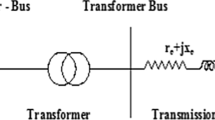Abstract
The earlier methods adopted for stability analysis of synchronous machines were based on approximations and idealizing assumptions. As such, the accuracy of prediction was limited. The advent of fast-acting computers having large memory space opened up the avenue for accurate analysis by handling detailed modelling. The earlier methods were based on equal area criterion or on swing equation or some of its modified form. But, the methods applied nowadays uses state space representation of the dynamic equations. The paper shows the steps to develop state space models (both with current and flux-linkage states) for transient stability analysis and the methods of linearizing the model about the operating point to assess dynamic stability. Two case studies have been given at the end to illustrate the methods.



Similar content being viewed by others
Abbreviations
- SCR:
-
Short Circuit Ratio
- TPS:
-
Thermal Power Station
- CMR:
-
Continuous Maximum Rating
- AVR:
-
Automatic Voltage Regulator
- O.C.C.:
-
Open Circuit Characteristic
- S.C.C.:
-
Short Circuit Characteristic
References
J.Y. Fan, T.H. Crtrneyer, R. Mukundan, Power system stability. IEEE Trans. Power Syst. 5(1), 227–233 (1990)
W. Stagg, A.H. EI-Abied, Computer Methods in Power System Analysis (McGraw-Hill Book Company, New York, 1968)
P. Kundur, Power System Stability and Control (McGraw Hill, New York, 1994)
B. Adkins, G. Harley, Generalized Theory of AC Machines (Chapman and Hall, London, 1957)
K. R. Padiyar, Power System Dynamics, ISBN: 1 904798 012 (IIT, Bangalore, 2008)
P. Kundur, P.L. Dandeno, Implementation of advanced generator models into power system stability programs. IEEE Power Eng. Rev. 7, 2047–2054 (1983)
K. Ogata, State Space Analysis of Control Systems (Prentice-Hall, Englewood Cliffs, 1967)
R.H. Park, Two reaction theory of synchronous machines, Part. 1. Trans. Am. Inst. Electr. Eng. 48, 716–727 (1929)
R.H. Park, Two reaction theory of synchronous machines, Part. 2. Trans. Am. Inst. Electr. Eng. 52, 44–45 (1929)
P.M. Anderson, A.A. Fouad, Power System Control and Stability (IOWA State University Press, Galgotia Publications, Lowa city, 1977)
V. Venikov, Transient Processes in Electric Power System (MIR Publishers, Moscow, 1980)
D. P. Kothari, I. J. Nagrath, Power System Engineering, 2nd. Ed, ISBN 10: 0070647917/ ISBN 13: 9780070647916 (Tata McGraw-Hill Education Pvt. Ltd., 2007)
F. Selwa, L. Djamel, Transient stability analysis of synchronous generator in electrical network. Int. J. Sci. Eng. Res. 5(8), 55–59 (2014)
M. Pavella, P.G. Moorthy, Transient Stability of Power Systems: Theory and Practice (Scitech, Goia´s, 1994)
T.K. Majumdar, A.N. Sanyal, B. Majumdar, Dynamic stability analysis of remote hydel power station connected to infinite bus through long transmission line. Indian J. Power River Valley Dev. 50(384), 67–70 (2000)
T.K. Majumdar, A.N. Sanyal, Reduced order model of a captive power plant for dynamic stability analysis, Vidyut Bharati 4(23), (2001)
A. Ghosh, A. Das, A.N. Sanyal, Transient stability assessment of an alternator connected to infinite bus through a series impedance using state space model. J. Inst. Eng. India Ser. B 100(5), 509–513 (2019). https://doi.org/10.1007/s40031-019-00397-w
F.P. Demello, C. Concordia, Concepts of synchronous machine stability as affected by excitation control. IEEE Trans. Power Appar. Syst. PAS-88, 316–329 (1969)
C.C. Young, Computer representation of excitation system. IEEE Trans. Power Appar. Syst. PAS-87(6), 1460–1464 (1968)
Author information
Authors and Affiliations
Corresponding author
Additional information
Publisher's Note
Springer Nature remains neutral with regard to jurisdictional claims in published maps and institutional affiliations.
Rights and permissions
About this article
Cite this article
Basu, M., Ghosh, A., Das, A. et al. Methods Adopted for Detailed Modelling of Alternators in State Space for Stability Analysis. J. Inst. Eng. India Ser. B 102, 87–98 (2021). https://doi.org/10.1007/s40031-020-00513-1
Received:
Accepted:
Published:
Issue Date:
DOI: https://doi.org/10.1007/s40031-020-00513-1




